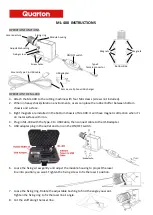
Description of fields
Field
Option
Description
Method
The type of transformation to be used when
determining a coordinate system.
Onestep
Transforms coordinates directly from
WGS 1984 to local grid and vice versa with-
out knowledge about the local ellipsoid or
the map projection. Procedure:
The WGS 1984 coordinates are projected
onto a temporary Transverse Mercator Pro-
jection. The central meridian of this projec-
tion passes through the centre of gravity
of the common control points.
The results of 1. are preliminary grid coor-
dinates for the WGS 1984 points.
These preliminary grid coordinates are
matched with the local grid control points.
The Easting and Northing shifts, the rota-
tion and the scale factor between these
two sets of points are then computed. This
process is known as a classic 2D transfor-
mation.
The height transformation is a single
dimension height approximation.
Refer to "I Glossary".
Twostep
Combines the advantages of the Onestep
and the Classic 3D transformation. It allows
treating position and height separately, but is
not restricted to smaller areas. Procedure:
The WGS 1984 coordinates of the common
control points are shifted closely to the
local datum using a given Classic 3D pre-
transformation. This Classic 3D transforma-
tion is typically a rough transformation
valid for the country of the local datum.
The coordinates are projected onto a pre-
liminary grid, but this time using the true
map projection of the local points.
A 2D transformation is applied, exactly as
with the Onestep transformation.
Refer to "I Glossary".
Classic 3D
Also known as Helmert transformation.
Transforms coordinates from WGS 1984 car-
tesian to local cartesian coordinates and vice
versa. A map projection can then be applied
to obtain grid coordinates. As a similarity
transformation, it is the most rigorous trans-
formation type and keeps the full geometri-
cal information. Refer to "I Glossary".
Determine Coord Sys-
tem
Determine Coordinate System
531















































